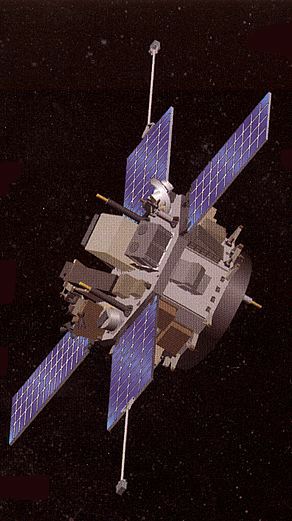
Back مستكشف التكوين المتقدم Arabic Advanced Composition Explorer BS Advanced Composition Explorer Catalan Advanced Composition Explorer Czech Advanced Composition Explorer German Advanced Composition Explorer Spanish Advanced Composition Explorer Finnish Advanced Composition Explorer French Advanced Composition Explorer Galician Advanced Composition Explorer Italian
 An artist's concept of ACE | |
| Names | Explorer 71 ACE |
|---|---|
| Mission type | Solar research |
| Operator | NASA |
| COSPAR ID | 1997-045A |
| SATCAT no. | 24912 |
| Website | www |
| Mission duration | 5 years (planned) 26 years, 10 months and 27 days (in progress) |
| Spacecraft properties | |
| Spacecraft | Explorer LXXI |
| Spacecraft type | Advanced Composition Explorer |
| Bus | ACE |
| Manufacturer | Johns Hopkins Applied Physics Laboratory |
| Launch mass | 757 kg (1,669 lb) |
| Dry mass | 562 kg (1,239 lb) |
| Dimensions | 2 m (6 ft 7 in) in diameter 1.9 m (6 ft 3 in) in length wingspan of 8.3 m (27 ft) |
| Power | 444 watts |
| Start of mission | |
| Launch date | 25 August 1997, 14:39:00 UTC |
| Rocket | Delta II 7920-8 |
| Launch site | Cape Canaveral LC-17A |
| Contractor | McDonnell Douglas |
| Entered service | 12 December 1997 |
| End of mission | |
| Deactivated | 2024 (planned) |
| Orbital parameters | |
| Reference system | Heliocentric orbit |
| Regime | Lissajous orbit |
| Perigee altitude | 145,700,000 km (90,500,000 mi) |
| Apogee altitude | 150,550,000 km (93,550,000 mi) |
| Inclination | ~0° |
| Period | 1 year |
| Instruments | |
| Cosmic-Ray Isotope Spectrometer (CRIS) Electron, Proton, and Alpha-particle Monitor (EPAM) Magnetometer (MAG) Real-Time Solar Wind (RTSW) Solar Energetic Particle Ionic Charge Analyzer (SEPICA) Solar Wind Electron, Proton and Alpha Monitor (SWEPAM) Solar Isotope Spectrometer (SIS) Solar Wind Ion Composition Spectrometer (SWICS) and Solar Wind Ion Mass Spectrometer (SWIMS) Ultra-Low-Energy Isotope Spectrometer (ULEIS) | |
 ACE mission patch Explorer program | |

Earth · Advanced Composition Explorer

Advanced Composition Explorer (ACE or Explorer 71) is a NASA Explorer program satellite and space exploration mission to study matter comprising energetic particles from the solar wind, the interplanetary medium, and other sources.
Real-time data from ACE are used by the National Oceanic and Atmospheric Administration (NOAA) Space Weather Prediction Center (SWPC) to improve forecasts and warnings of solar storms.[1] The ACE robotic spacecraft was launched on 25 August 1997, and entered a Lissajous orbit close to the L1 Lagrange point (which lies between the Sun and the Earth at a distance of some 1,500,000 km (930,000 mi) from the latter) on 12 December 1997.[2] The spacecraft is currently operating at that orbit. Because ACE is in a non-Keplerian orbit, and has regular station-keeping maneuvers, the orbital parameters in the adjacent information box are only approximate.
As of 2023[update],[3] the spacecraft is still in generally good condition, and is projected to have enough propellant to maintain its orbit until 2024.[4] NASA Goddard Space Flight Center managed the development and integration of the ACE spacecraft.[5]
- ^ "Satellite to aid space weather forecasting". USA Today. 24 June 1999. Archived from the original on 18 October 2009. Retrieved 24 October 2008.
- ^ "Operations Day -- 346/1997 (12 December 1997)". srl.caltech.edu. 31 December 1997. Retrieved 28 October 2021.
- ^ "ACE (Advanced Composition Explorer) - Mission Status". ESA eoPortal Directory. 15 June 2021. Retrieved 29 October 2021.
- ^ Christian, Eric R.; Davis, Andrew J. (10 February 2017). "Advanced Composition Explorer (ACE) Mission Overview". California Institute of Technology. Retrieved 14 December 2017.
- ^ "Display: Advanced Composition Explorer (1997-045A)". NASA. 28 October 2021. Retrieved 28 November 2021.
 This article incorporates text from this source, which is in the public domain.
This article incorporates text from this source, which is in the public domain.